Tag: home cooking
June 30
A couple of weeks ago, while researching rhubarb crumble recipes for the Crisps and Crumbles episode of Spilled Milk (still going strong, 52 weeks a year! and still featuring impromptu hair-metal duets!), I pulled down an old copy of Canal House Cooking, and it fell open to page 57, “Cutlets Smothered in Peas.” That’s when it dawned on me that I had somehow made it to age almost-39 without ever cooking a chicken cutlet, and that my child had somehow made it to age almost-five without ever eating a chicken cutlet. I understand this makes one subject to ridicule and rebuke not only in America, but also in many other parts of the world, including Japan, where panko-breaded, pan-fried chicken or pork cutlets (katsu) are, I hear – and hope to see for myself one day – a national staple.
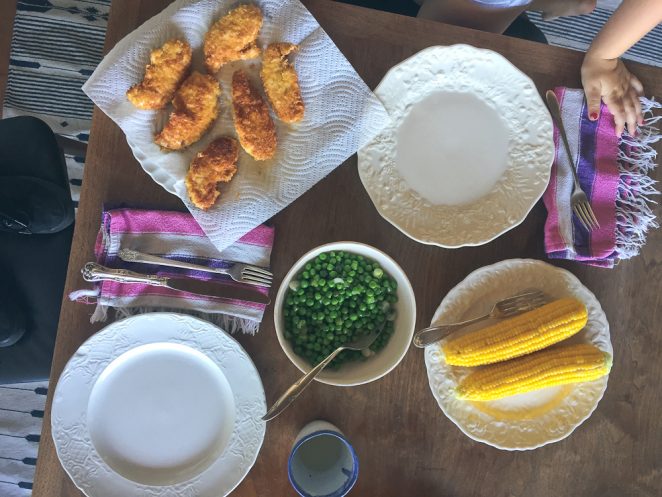
You probably already know how to cook chicken cutlets? I didn’t, and the Canal House recipe didn’t go into much detail, so I texted Matthew, who knows how to cook almost everything. The recipe below is quick and loose, a combination of Matthew’s instructions, some online recipe-reading, and Canal House’s smothered pea idea, banged out on my electric stove on a warm June night as an early dinner for two. (If you’re looking to do traditional katsu, which calls for pounding the meat to an even thinness and frying with greater exactness, Kenji Lopez-Alt has an excellent method.)
I recommend serving cutlets and peas with corn on the cob, cooked quickly in a skillet of simmering, well-salted water. In my experience, almost-five-year-olds are great at buttering corn on the cob. They can also participate in the chicken-dredging process, provided that your almost-five-year-old is a good hand-washer (and/or you are an exacting hand-washing supervisor). Almost-five-year-olds can also set the table. They may choose to do all of the above wearing only underwear and chipped nail polish. Upon taking a first bite, they may even exclaim, “I love this recipe!” Almost-five-year-olds are the greatest, except when they are not.
(A normal old recipe post! That was fun.)
Also:
- The aforementioned Matthew and I are teaching a two-day travel writing workshop at the Pantry on July 15th and 16th. Please join us. The description reads thus: The best travel writing brings you all of the discovery, disasters, and deliciousness of travel with none of the flight delays. But how do you write about a place without sounding like a Chamber of Commerce brochure? In this two-day workshop, bestselling authors Molly Wizenberg and Matthew Amster-Burton will show you how to find the story in a destination, zoom in on meaningful details, and understand right and wrong ways to put yourself into the story. To get you there, we’ll explore selections from writers like Fuchsia Dunlop, Ann Patchett, Rachel Khong, Bill Bryson, and more. Sign up via The Pantry.
- I’m reading Sherman Alexie’s new memoir, and it’s difficult and funny and immensely good. I loved his recent interview with Terry Gross on NPR’s Fresh Air.
- I wish Rookie had existed when I was a teenager. Of course, that doesn’t stop me from reading it now, and I’ve listened to every episode of the Rookie podcast. Tavi’s recent interview with writer and transgender activist Janet Mock was especially inspired. And don’t miss Roxane Gay on bodies, writing, and more.
Hi. We’re well, and I hope you are too.
Chicken Cutlets Smothered in Peas
Inspired by Canal House Cooking, Vol. 6: The Grocery Store
June didn’t like the scallion flavor in the peas, so next time, I’ll be leaving the scallions out. I like it either way.
Set out three shallow bowls. Put a large, heaping spoonful of flour in the first, the egg in the second, and a large, heaping spoonful of panko in the third. I didn’t measure the flour or panko, and I think you can safely eyeball it. Beat the egg well with a fork.
Season the cutlets with kosher salt.
Working with one cutlet at a time, dredge in flour with one hand, shaking off excess. Transfer to the egg dish, turning the cutlet with your other hand to coat both sides. Lift, allowing excess egg to drain off. Transfer to the panko bowl. With your first hand, scoop panko on top of the cutlet and gently press to adhere, taking care that the whole thing is coated. Transfer to a clean plate. Repeat with remaining cutlets. If this is done properly, your first hand should touch only dry ingredients, while your second hand should touch only wet, and ideally it’s not too messy. If it is, oh well.
Pour oil into a 10-inch skillet to a depth of ¼ to 1/3 inch. Place over medium-high heat. When the oil shimmers and runs loosely around the pan when you tilt it (around 350°F), gently lower the cutlets into the pan, laying them down away from you to prevent splashes of hot fat. Don’t crowd the pan; cook in batches if necessary. Cook cutlets until the bottom side is set, and then flip and fry until the second side is set. Continue cooking, flipping occasionally for even browning, until the cutlets are golden brown – fried-chicken color – and cooked through, about 4 to 5 minutes per side. I use a Thermapen to test for doneness, pulling cutlets from the pan around 155°F. They will rise to 165°F (the USDA safe temperature) as they rest. Transfer to a plate lined with a paper towel.
Meanwhile, melt the butter in a saucepan over medium heat. Add the peas and scallions and a generous dash of salt, stir to coat, cover, and cook until tender. I didn’t time this. Maybe 10 minutes?
Serve everything hot, the buttery peas spooned over the cutlets.
Yield: 2 to 3 servings
October 3

I started my Monday by listening to Blood Orange until my ears fell off, which was nice. Then my friend Jenny told me to watch this (old-news) video (that I somehow had never seen before), and with that, my week is off and running. Hi to you. Now, business: 1. The Guardian kindly invited me to write about a food that evokes home, and I wrote about a dead-simple, bare-cupboard soup that was first made for me by my aunt Tina. That’s her below, on the right, living the early-eighties hot tub life with me and my cousins. Most people thinks that June gets her hair color and texture from Brandon, but world, let it be known that I think she’s got my texture…
Read moreCooking with a young child
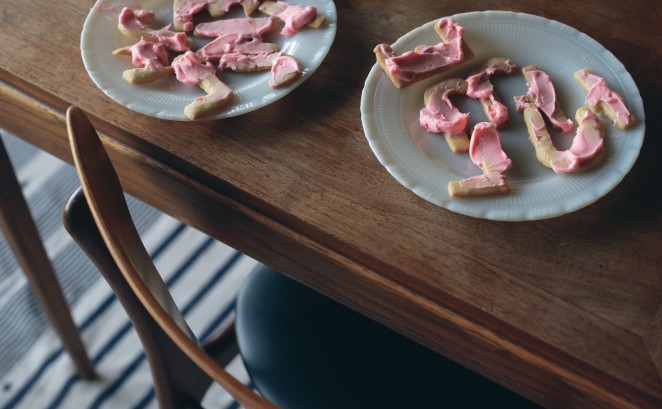
Today, on the ole blog: some thoughts about cooking with a kid! After the jump! Because I totally get that not everyone wants to read about kid stuff! See you next time!
Read moreEven on a good day

My mother has been in town since early this month. We don’t often get this kind of extended time in the same place, and I’d forgotten what a good cooking collaborator she is. She makes sure our wine glasses are never empty. She cleans up as she goes. She doesn’t mind deveining shrimp! I could go on and on. I bow down. At my reading in Madison last week, someone asked me to talk about a few of my favorite cookbooks. The ones I mentioned were The Zuni Cafe Cookbook, All About Braising, various Nigel Slater titles, and Every Grain of Rice, and because I am long-winded, my answer wrapped up, blah dee blah blah, about twenty-five minutes later, on the topic of…
Read moreIt’s all there
Well. That took a little longer than I expected. Thank you for hanging in there, and even more, for being so understanding. I missed you all, and I missed being here. I was having a pretty rough time a couple of months ago. You could probably see it more clearly, actually, than I could. I have never, ever, done something as consuming as this opening-a-restaurant business. Even writing a book doesn’t compare. People had warned us that projects like these always take twice as long and cost twice as much as you expect them to, and dude, that is Seriously. No. Joke. It’s been like Little Shop of Horrors over here, only the role of Audrey II, the man-eating plant,…
Read moreIt really does help
A few evenings ago, I felt very uninspired about making dinner. This has been happening a lot lately, far more than I should probably admit, as someone who is supposedly crazy about cooking. I could attribute it to lots of causes, but I think these things go in cycles for all of us, these urges to cook or not cook, and no matter our individual circumstances, it’s only sane to acknowledge that. Sometimes I want to make two types of sauce gribiche, and other times, I want to claw my eyes out and then call for a pizza delivery. I know I should try to find some sort of happy medium in this, and maybe I will someday. But in…
Read moreSomething called sauce gribiche
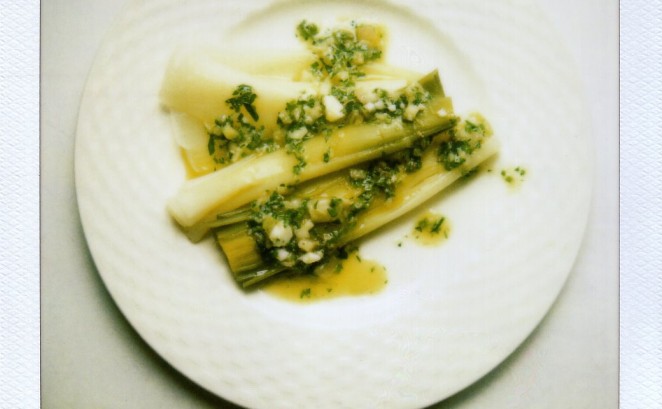
About five years ago, I think it was, I went out to dinner with my friend Keaton and ate something called sauce gribiche. I had never heard of it before, but it was a kind of coarse vinaigrette, with chopped cornichons and capers and hard-boiled eggs, and it was served over asparagus. I don’t know why I remember it so clearly, aside from the fact that I dripped some of it onto my pants, but ever since, I’ve thought about it sometimes, usually when I’m supposed to be thinking about more important things, and I’ve wanted to try making it. It took me a while, as you can see, but yesterday, I finally did. Twice. The thing is, as I…
Read moreAbout cake
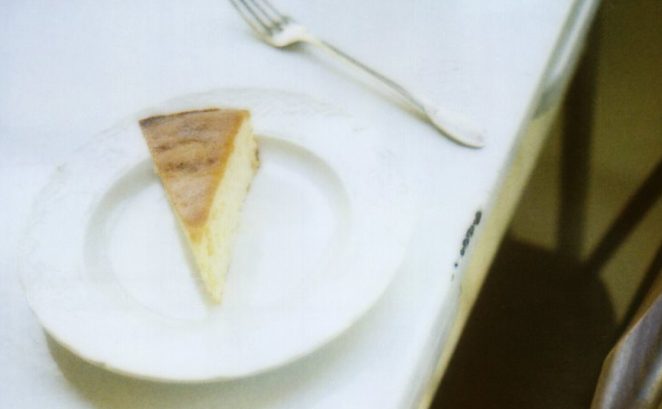
Today, I thought it would be nice to talk about cake. Actually, that’s a lie. Today, I thought it would be nice to eat cake. That’s all. Anything else is completely optional. I’m easy to please, as long as there is cake around. Lately, I’ve been thinking a lot about cake. This is not an unusual condition for me, but it happens particularly often when I’m feeling frazzled or tired or harried, right around the same time that I start listening to the easy listening station on the car radio and feeling genuinely soothed by it. It’s pretty clear that you need a good night’s sleep when “Peaceful Easy Feeling” comes on the stereo and you almost choke up, sitting…
Read moreThe truth is
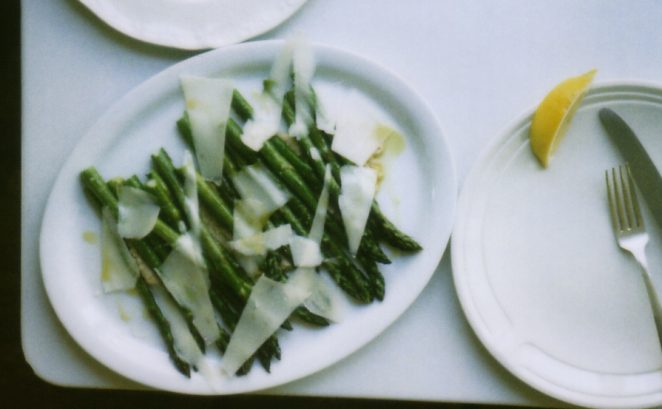
I have to tell you something sort of unpleasant today, but somehow, I don’t think you’re going to be surprised: I have not been doing much cooking lately. I was hoping to be able to avoid the topic, but I can’t. There is a lot going on over here, and you can see it as clearly as I can, so there’s no point in trying to fool anyone. The truth is, for the past week, we’ve been living on a pot of pinto beans spiked with Tapatio, four steamed artichokes, a few pans of scrambled eggs, a quart of ice cream, one bag of Cool Ranch Doritos, and one bag of Blazin’ Buffalo & Ranch Doritos. I am not too…
Read moreI mean it
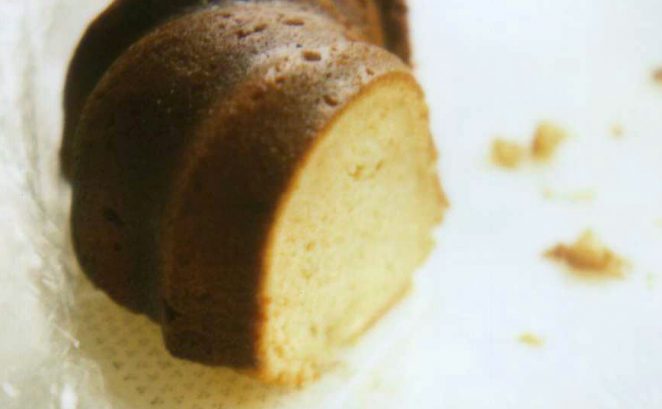
I would like to sit down here today and write as though everything were normal, as though I were actually capable of forming complete sentences. But the truth is, I am an absolute maniac. Tomorrow is the official release date for my book, a day that I never really trusted would come, and I feel alternately so ecstatic and so freaked out that I can’t decide whether I need to run around the block a few dozen times or lie down for a nap. In the meantime, I will eat some sweet potato pound cake. As you can see, that’s been my fallback position for a few days now. Many of you have written already(!) to say that you have…
Read moreNow you know
I have a confession to make. It probably seems like I live and breathe to cook, right? It probably seems like I never get tired of stirring and whisking and chopping, like I go to sleep at night spooning the refrigerator and wake up each morning to find a skillet under my pillow and a rainbow arcing gently, benevolently, over the stove. But the truth is, there are many days when I would rather do anything than cook. ANYTHING. Like, hit-myself-over-the-head-with-the-aforementioned-skillet anything. Anything. Lately, I’ve been having a lot of those days. At first, I thought it was because of my recent run of bad recipes. It’s hard to feel terribly excited about spending time in the kitchen after you’ve…
Read more
